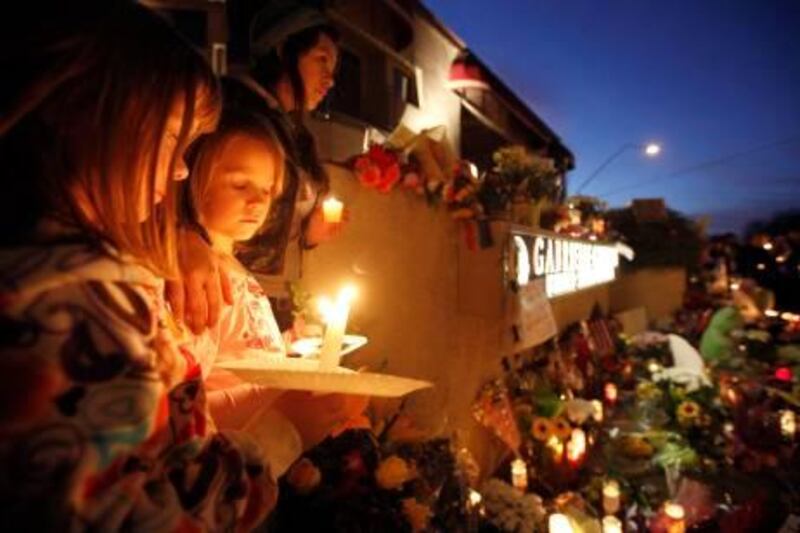WASHINGTON // As the US president, Barack Obama, led Americans in a moment of silence yesterday for those slain in Saturday's shooting spree in Arizona, the nation tried to determine why it happened.
Most of the debate centred on gun control and a harsh political atmosphere that some say contributed to the Tucson shooting that left six dead, and 12 wounded.
Among the injured was Gabrielle Giffords, a Democrat congresswoman, who remains in a critical condition and who investigators believe was the target for the shooter.
Both issues were raised by Clarence Dupnik, the outspoken Arizona sheriff and one of the lead investigators into the case.
At a press conference late on Saturday, Mr Dupnik singled out "the vitriol that comes out of certain mouths about tearing down the government".
The remark was taken as a clear reference to the right-wing rhetoric, often associated with the Tea Party movement.
It was not long before it was noted, largely by Democrat-leaning pundits and bloggers, that Ms Giffords had found herself on a "target map" with gun sight cross hairs that had been disseminated by those working for Sarah Palin, the 2008 Republican vice presidential candidate and Tea Party backer, last year.
The map was meant to illustrate the elections Mrs Palin thought Republicans needed to "target" in the elections. But it has been seized on, along with Ms Giffords's remarks about the map at the time, as an example of the political tactics that Mr Dupnik suggested "unbalanced" people were "especially susceptible to".
It was a point made by columnist Paul Krugman in yesterday's New York Times. Noting a 2009 Homeland Security report that warned of a rise in recruitment of right-wing extremist groups, spurred both by a faltering economy and the election of Mr Obama, Mr Krugman denounced what he called a "climate of hate".
"Where's that toxic rhetoric coming from? Let's not make a false pretence of balance: it's coming, overwhelmingly, from the right," Mr Krugman wrote, citing several examples of what he called "eliminationist rhetoric".
Right-wing and Republican-leaning pundits and bloggers have found themselves on the defensive, but it was not long before some came up with target maps similar to Mrs Palin's that had been employed by Democrats, including one used in the 2004 presidential election campaign that used graphics of bull's-eyes to illustrate campaign strategy.
Conservative pundits are now accusing Democrats and liberals of trying to score cheap political points out of a tragedy. Fox News quoted Peter Wehner, a senior fellow at the Ethics and Public Policy Centre in Washington, who called the comments of Mr Krugman and others "sickening". "People were taking a terrible human tragedy and using it as a political club, and there wasn't even a moratorium of 24 hours, or even 24 minutes," Mr Wehner told Fox.
The debate on gun control, a perennial issue in the US, has proven no less divisive. More than 30,000 Americans die every year in gun violence. More than 12,000 of these are homicides, the rest are suicides or accidental shootings.
The Arizona Daily Star noted in an article yesterday that Jared Lee Loughner, the suspect in the shooting, was able to walk into a sports shop last November, pay US$550 (Dh2,000) and walk out with the Glock semi-automatic that he used on Saturday.
Yet Americans are remarkably resistant to attempts at curtailing gun ownership. Indeed, on blogs and online postings since Saturday, not least on the Facebook page of Sarah Palin, who is fervently anti-gun control, fans made the case that the Tucson shooting showed the need for more guns, not fewer.






